► Secondhand buying advice for Lotus sports cars
► Tips on Elise S1, Exige S2, Evora and Esprit
► A used Lotus masterclass
And in other news, at a service at Buckingham Palace earlier today, IT manager David Giles was presented with the George Cross for disregarding the livelihood of his entire family by pouring his own life savings into a used Lotus, an act of such bravery, even Her Majesty was moved to describe it as ‘sheer madness’.
Know-nothing bar-room experts will tell you that buying a pre-enjoyed Lotus will end in more tears than an Oscar acceptance speech, but we, and the specialists who really know these cars, beg to differ.
We’ve gathered four machines here, cars that have given their owners virtually no trouble, but more pleasure than a Lancastrian beach, each car as different in price as in purpose, but all gauranteed to plaster a grin across your face entirely out of proportion with the price in the window.
Click here to browse second-hand Lotus sports cars in our Cars For Sale section.
Lotus Elise S1: the very purest kind of modern sports car
And no car here quite fits that brief like the original S1 Elise. The car that transformed Hethel’s late 1990s fortunes was a radical departure from its Elan predecessor, eschewing that car’s turbocharged front-engined, front-drive layout for a naturally aspirated mid-engined design based around a radical bonded and riveted aluminium chassis. Nearly 20 years on, only the emergence of relatively affordable carbon-based cars such as the Alfa 4C makes the Elise’s structure seem any less exotic.
I’d forgotten how dainty these things are. It looks like a 3/4 scale model, the bug-eyed, snake-faced styling of this early car less exotic but more macho than the 2000 facelift car that followed. Reptilian levels of dexterity are useful when it comes to slotting yourself between the high, wide sill and roof, normally a roll-up canvas affair that looks like a tool roll, but in this case, a removable hardtop. Forget thoughts of seat, wheel and pedals being in anything other than approximate alignment, and even the luxury of carpets in most cases, the Elise experience is very much sports car redux, and all the better for it.
The original Elise came with a bone-stock MG Rover K-series engine developing just 118bhp, which felt more like 200bhp when you factored in the scarcely believable 725kg kerbweight, or there was the 111S, featuring the VVC version of the K-series producing 143bhp and mated to a lovely close-ratio ’box. Simon Cowlin’s car, pictured here, is even more special. It’s a super-rare Sport 160, a track-focused version featuring uprated suspension and cammy 160bhp motor that idles like a racer.
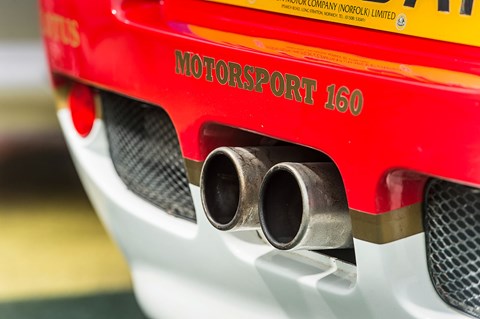
If you’ve never driven an Elise before, for those first few hundred yards your senses are as overloaded as a Mumbai commuter train. The steering wheel, writhes away in your hands, weighting up markedly in corners, and while first-generation Elises had a reputation for slightly spikey handling, this one is a peach, feeling so light and playful, and happy to be steered on the throttle through the damp turns of Hethel’s recently resurfaced track.
The wheel isn’t the only unservoed control either: the brakes, as with those on all K-series-engined cars, are boost-free too, requiring a very unfashionable race-car shove that makes them brilliantly easy to modulate, but requires a proper old-fashioned heel-and-toe action for downchanges: a lazy roll of the foot won’t cut it here.
Any concerns that ‘only’ 160bhp will leave you wanting more are quickly banished as the little engine comes on cam and shrieks towards the limiter. Even the famously vague gearshift feels far sweeter than I remember. I’m mentally loading up the Classiccarsforsale.co.uk website before I’ve pulled in, and once stopped, two minutes of classified searching on my iPhone reveals S1 cars start at under £8k. Surely these things must be ready to rocket in price?
An Elise makes a fine road car, and cost-effective track tool. Low weight means it’s light on its brakes and tyres. But if you’re circuit serious, and the budget can take it, you might want to consider its bad-boy brother. Chippy Chas to the Elises’s mild-mannered Morph, the original Exige was launched in 2000 using S1 design cues despite Lotus launching the slinkier S2 Elise just months later. Powered by a screaming 177bhp version of the K-series or even crazier 192bhp VHPD (Very High Performance Derivative), these S1 Exiges are as highly collectable as they are highly strung, their two-year production lifespan meaning they’re thin on the ground and command a minimum £25k investment.
Lotus Exige S2: the tin-top Elise
They’ve got future classic written all over them, but if you want a car to drive without mechanical drama, we’d fast forward a few years. When Exige 2 appeared in 2002 it wasn’t only the design that differed. Under the wobbly plastic tailgate there was a new engine, another naturally aspirated 1.8, this time from Toyota, packing 189bhp, and backed up by the car’s first six-speed gearbox. But the best was yet to come. In February, Lotus released a limited run of 50 Exiges called 240R, the power of each boosted to 243bhp by the addition of a turbocharger. Twelve months later a 220bhp version joined the line-up full time.
Duncan Innes’s Exige S is such a car. Painted in exactly the sort of lurid retina-wrecking hue you’d want for a car this extrovert, and featuring a wider track, aggressive roof snorkel and massive rear spoiler, it looks like an Elise that’s been seduced by jihadists and spent the last six months at a clandestine training academy in Pakistan.
Slot yourself below the fixed hardtop and the view forward including instruments and dashboard do little to indicate that this is more than an Elise with a roof. 4 The view behind begs to differ. Legally, Lotus was obliged to fit a rear-view mirror, but you’d be best off binning it and saving a few ounces because all you’ll see is the huge intercooler strapped to the top of the 2ZZ-GE four-pot.
Best to concentrate on the stuff out the front window anyway: light weight pushed the original 118bhp Elise to 62mph in under 6sec; but a fatter 158lb ft of torque means this car gets there in a Ferrari-like four-three. The gearchange on these Toyota-engined cars was always much cleaner than the slightly muddy S1 shift, though the engine noise isn’t the cultured growl the supercar styling and acceleration figures might suggest.
It’s hard to imagine any car making an Elise feel a little soft, but the extra precision and stability wrought by the Exige’s chassis mods is striking. The steering is even crisper, roll is slashed like sofa prices once Santa’s beat his retreat, and call us wimps but the servo-assisted brakes are so much easier to use.
Lotus Evora: a grown-up kind of sports car aimed at the 911
For a Lotus, everything is easy when it comes to the Evora, which at £30k sounds far more tempting than the same machine at double the price when new. The Evora was Norfolk’s answer to the Porsche 911. Or was it the Cayman? In reality it was a cross between the two, priced like the big guy but performing like its little brother, thanks to the balance of a mid-engined layout which rendered its tiny optional rear seats useless.
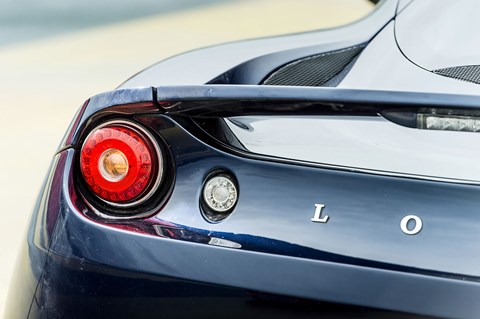
This car’s owner, David Fraser, says he’s never seen another despite using it to commute into London – prime Evora territory, you’d think, given the proliferation of Porsches in the capital. They don’t know what they’re missing because the Evora is sensational to drive. Steering that communicates better than a hostage negotiator despite its power assistance connects you to a front end that responds as if it’s on slicks. Yet the thing rides like its wearing 80-series balloon tyres. How do they do it?
Early cars like this one all came with a 3.5-litre Toyota V6 producing 276bhp and mated to a (in the first cars, slightly imprecise) six-speed gearbox. Stepping into it from the blown Exige highlights what feels like modest low-end torque (although it’s actually 100lb ft stronger than the Exige; blame the 1300kg+ weight). But it’s such a sweet engine, that wringing it out is no chore, provided you remember to press the Sport button to unfurl an extra 500rpm of leash. Stir the pot and you’ll arrive at 62mph in just over 5sec. Want more? You need its supercharged Evora S companion, which arrived in 2010 packing 345bhp, though you’ll pay £40k for the privilege, and it’s a disappointingly tuneless affair.
The cabin feels a little too cosy compared with a contemporary Porsche, and the instruments are difficult to read, but when it comes to refinement the Evora is light years away from its Elise brothers. Road noise is relatively hushed and, while getting in and out still requires a course of cod liver oil tablets, training by the Cirque du Soleil acrobats is no longer necessary.
Good as the Evora is though, you have to wonder whether it will ever attain the cult status of its grandad. For two decades the Esprit was the backbone (boom, boom. Sorry, Lotus anorak humour) of the Lotus cars range, and gentleman of a certain age hanker after one now as much as they always did.
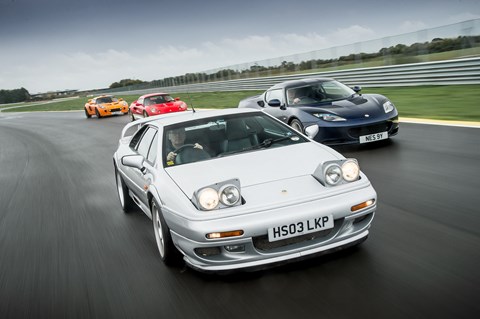
The original Esprit S1 made famous in The Spy Who Loved Me might have looked like a supercar, but with a 160bhp 2.2-litre four slotted behind the seats it didn’t go like one. The Esprit Turbo that followed certainly did, but it didn’t sound like one. Only in 1995, by which time Giugiaro’s original origami creases had been smoothed twice, first by Peter Stevens, and then Elise designer Julian Thomson, did Lotus finally give the Esprit the engine it deserved. Well, almost. Developed in-house, the 3.5-litre twin-turbo V8 gained a reputation for terrible reliability, and with its Ferrari-style flat-plane crank, stood accused of sounding no more melodic than the four it replaced.
I can’t say I’ve much complaint about the sound coming from the back of Richard Flegg’s car, though apparently much credit must go to the sports exhaust. The visibility is tremendous too, and the brakes feel more than up to the task of hauling in the effect of 295lb ft on a 1380kg missile. But it’s clearly a much older design and much bigger car, and lacks the intimacy of its little brothers on track. Of the cars here, this is the one I take longest to gel with, largely thanks to strangely mismatched control weights that deliver a leaden throttle response but flyweight brakes and steering.
A long drive should help cement the relationship, and that’s exactly what its owner says it excels at. Despite its butch appearance, Richard says his car – one of the final handful produced, and displaying the circular rear lights of the previous year’s final facelift – works brilliantly as a GT, eating up Le Mans miles every summer, and proving far more useable than you’d imagine.
Word is getting around, too. After years in limbo, values of sound Esprits, much like those of the best examples of its TVR Cerbera contemporary, are hardening. The early cars are rising fast, S1s and Essex Turbos fetching over £50k, and V8s are beginning to move from the shadow of unreliability, to gain a cult following – though Bell and Colville’s Scott Walker says a four-cylinder GT3 is more fun, more reliable and costs 20% less.
Which Lotus you should choose largely depends on your budget and what you want to do with it. But with the S1 Elise at the bottom of its depreciation curve, still offering a purer driving experience than almost any other car on the road and the likelihood of almost non-existent running costs, all for less than the price of a Fiesta, we know where we’d be sinking our money.
Read on for our detailed buying guides on each secondhand Lotus.
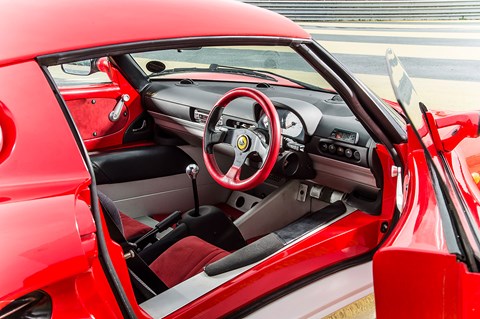
How to buy a used Lotus Elise S1: buyer’s checklist
‘Buy the most unmolested, lowest mileage car you can,’ says Jamie Matthews, sales manager at Bell and Colville. ‘Avoid a car that’s suffered chassis damage, but don’t be scared by a replacement clam provided the work’s been done by an approved Lotus repairer.’ Buying a £7k car over a £10k with the same mileage might seem madness, but a cheap car that needs a cambelt, a set of tyres, new balljoints and stone chips sorting can soon turn into an expensive one. Only a fraction of the S1 Elises came in 111S spec and they’re hugely more desirable, commanding at least a £2-3k premium, while the very best low-mileage cars are over £25k. Don’t just look for a stamped service book. If the history file is stuffed full of invoices it suggests fastidious former owners. If you’re after cast-iron reliability and don’t want to add to that file more than necessary, it’s worth looking to a Toyota-engined S2.
Why it’s here Purest driving experience this side of a Caterham
Years built 1996-2000
Spec secret Early cars had composite brake discs, rare now
Reality check Loads have been stuffed. HPI check essential
Engine 1796cc 16v 4cyl, 118bhp @ 5500rpm, 122lb ft @ 3000rpm
Transmission Five-speed manual, rear-wheel drive
Performance 5.5sec 0-60mph, 124mph
Weight 725kg
One we found 2000 W Elise Sport 160, 75k, Janspeed exhaust, recent head gasket, new clutch, rack and ball joints, £11,490
Price then £19,950
Price now £9000
Feeling inspired? Click here to browse second-hand Lotus sports cars in our Cars For Sale section.
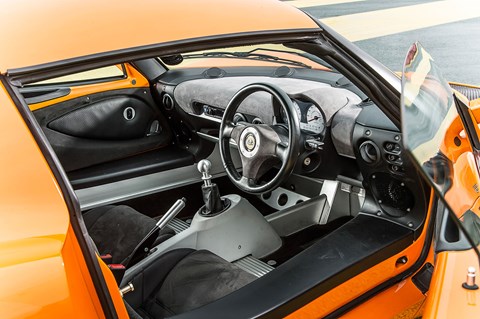
How to buy a used Lotus Exige S2: buyer’s checklist
If you want an Exige to drive, an S2 is the one, says Jamie Matthews. The Toyota engine is reliable, chain driven so there’s no cambelt to change, clutches last forever, and the cars are cheap. But prices are still falling, so a pricier S1 makes a better long-term investment. Most of these cars will have seen some track action, and that’s no de-merit so long as it hasn’t lived every weekend on circuit and the service file shows a level of care to suit. Even so, stick to unmodified cars to retain value. Most of these cars have air conditioning, and it actually makes sense with such a confined cockpit. You’ll pay £1-2k more for an air con-equipped car, but condensors can fail so check it actually works. Naturally aspirated S2s start in the high teens, but most buyers want the extra grunt of the supercharged S, if they can afford the low-to-mid £20ks price tag.
Why it’s here Ferrari Scuderia for the price of a Fiat Scudo
Years built 2002-2012
Spec secret Optional Touring Pack included leather seats
Reality check It sounds like a Hoover and a waste disposal unit getting jiggy
Engine 1796cc 16v 4cyl supercharged, 218bhp @ 7800rpm, 159lb ft @ 5500rpm
Transmission Six-speed manual, rear-wheel drive
Performance 4.3sec 0-62mph, 148mph, 31mpg
Weight 935kg
One we found 2007/07 Exige S, metallic blue, air conditioning, 16k miles, harnesses, full history, fire extinguisher, £25,000
Price then £34,824
Price now £23,000
Feeling inspired? Click here to browse second-hand Lotus sports cars in our Cars For Sale section.
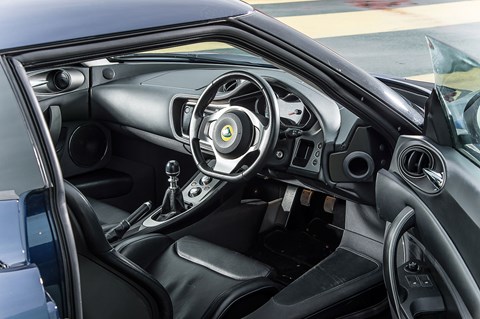
How to buy a used Lotus Evora: buyer’s checklist
Lotus released the Evora before it was really ready and there were warranty issues with parts like the air conditioning and exhaust mounts, so check to see that all the warranty updates have been carried out. Don’t bother looking through the history file for a cambelt change; like the Toyota four-pot in the later Elise and Exige, the Evora’s V6 is chain driven. It does need servicing once a year, which will set you back just over £400 for a minor one and £700 for a major fettle. Lotus launched the IPS paddle-shift Evora in 2010. They’re worth about £1k more than a manual, but it’s a conventional auto, not a dual-clutch ’box and therefore not as much fun. Cars tend to come either fully loaded with extended leather and navigation, or pared down, maybe with the desirable sports ratio gearbox. The latter are the best to drive and cost £2k less. The Premium pack (more leather, heated seats, accent lighting) is worth £2-3k extra.
Why it’s here Makes a Cayman feel like an MPV
Years built 2009-date
Spec secret Auto option arrived in 2010
Reality check Those back seats… are nothing of the sort
Engine 3456cc 24v V6, 276bhp @ 6400rpm, 252lb ft @ 4700rpm
Transmission Six-speed manual, rear-wheel drive
Performance 5.0sec 0-62mph, 162mph, 32.5mpg
Weight 1350kg
One we found 2009/59, Evora V6, blue, oyster leather, 31,000 miles, sports exhaust, tech pack, comprehensive history, £28,995
Price then £48,445
Price now £29,000
Feeling inspired? Click here to browse second-hand Lotus sports cars in our Cars For Sale section.
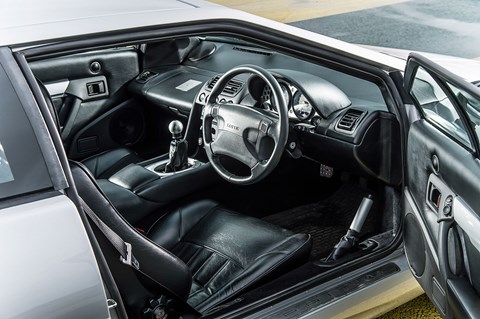
How to buy a used Lotus Esprit V8: buyer’s checklist
‘You’ll see V8s in the classifieds for £18 or £19k,’ says Bell and Colville’s Scott Walker. ‘But I’d always advise to set your sights on cars in the £25k range.’ A nice low-mileage V8 can make over £30k. The V8 was Lotus’s own design and suffered from a well-publicised cylinder-liner problem that caused overheating in the early years. If an engine does properly let go, you’re looking at £10k to rebuild it. The engine itself isn’t the only source of problems. Fuel tanks and turbo pipes rot and oil coolers can split. The parts supply situation isn’t anything like as good as for the Elise, either. The V8’s torque makes it huge fun, but it’s a relatively heavy beast. If you want the purest Esprit experience, the four-pot GT3 is sharper and costs less than £20k. It’s Lotus’s 911 GT3 and a bona-fide future classic.
Why it’s here Half the price of a Ferrari F355
Years built 1996-2003
Spec secret Sport 350 is limited run trackday hero
Reality check Supercar looks and some supercar-esque bills too
Engine 3506cc 32v V8, 350bhp @ 6500rpm, 295lb ft @ 4250rpm
Transmission Five-speed manual, rear-wheel drive
Performance 4.9sec 0-62mph, 175mph, 21.2mpg
Weight 1378kg
One we found 1997 P Esprit V8, two new turbos, clutch, cambelt, tyres, fortune spent, yellow, grey leather, £25,000
Price then £59,995
Price now £25,000
Feeling inspired? Click here to browse second-hand Lotus sports cars in our Cars For Sale section.